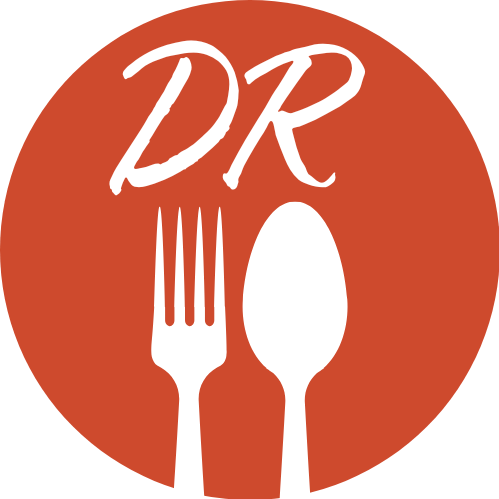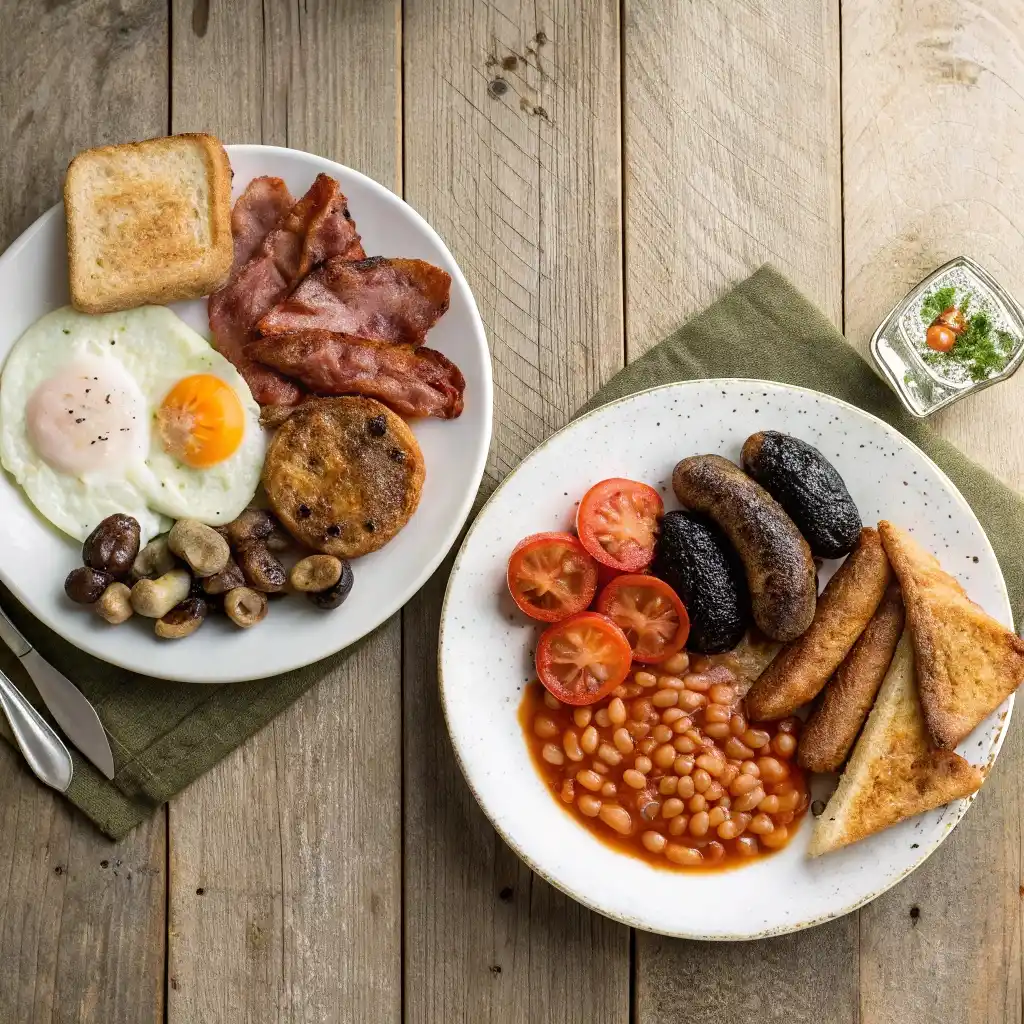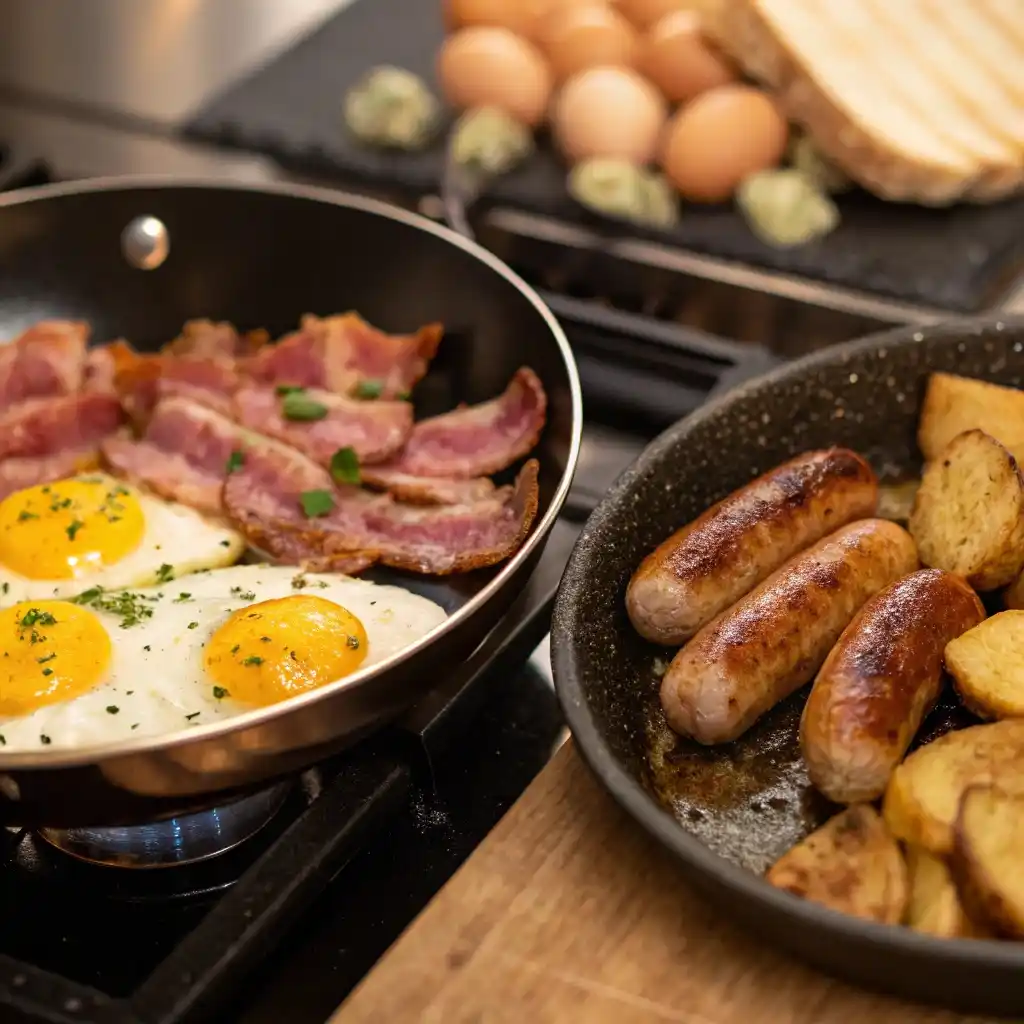
The debate of a Full Irish Breakfast vs Full English Breakfast has long intrigued food lovers. Both meals are hearty, traditional breakfasts enjoyed in Ireland and England, showcasing local ingredients and cultural heritage. While they share similarities like bacon, sausages, and eggs, distinct differences set them apart. In this article, we’ll explore each iconic breakfast’s unique components, history, and cultural significance.
What is a Full English Breakfast?
Definition and Historical Context
The Full English Breakfast, often referred to as a “fry-up,” dates back to the 13th century when it symbolized hospitality among the English gentry. By the Victorian era, it became a popular morning meal for the working class, providing energy for physically demanding workdays. Today, it is a beloved staple in British culture, often enjoyed on weekends and at traditional cafés or pubs.
Common Components of a Full English Breakfast
A typical Full English Breakfast includes the following savoury and satisfying components:
- Back Bacon: A leaner cut of bacon, often grilled or fried.
- Sausages: British-style pork sausages seasoned with herbs.
- Eggs: Fried, scrambled, or poached.
- Baked Beans: A sweet and savoury addition, served in tomato sauce.
- Grilled Tomatoes: Halved and lightly seasoned.
- Mushrooms: Sautéed in butter for an earthy flavour.
- Black Pudding: A traditional blood sausage with oats and spices.
- Toast or Fried Bread: Buttered toast or bread fried in bacon fat.
- Optional Hash Browns: A modern addition, offering a crispy potato side.
This combination of items delivers a rich and savoury meal that remains a cultural icon across England.
What is a Full Irish Breakfast?
Definition and Historical Origins
The Full Irish Breakfast shares historical roots with its English counterpart but has developed its regional identity. Historically, it was a staple for Irish farmers and labourers, providing the energy needed for long work days. Today, it is served in homes, hotels, and cafés throughout Ireland, often paired with a strong cup of tea or coffee.
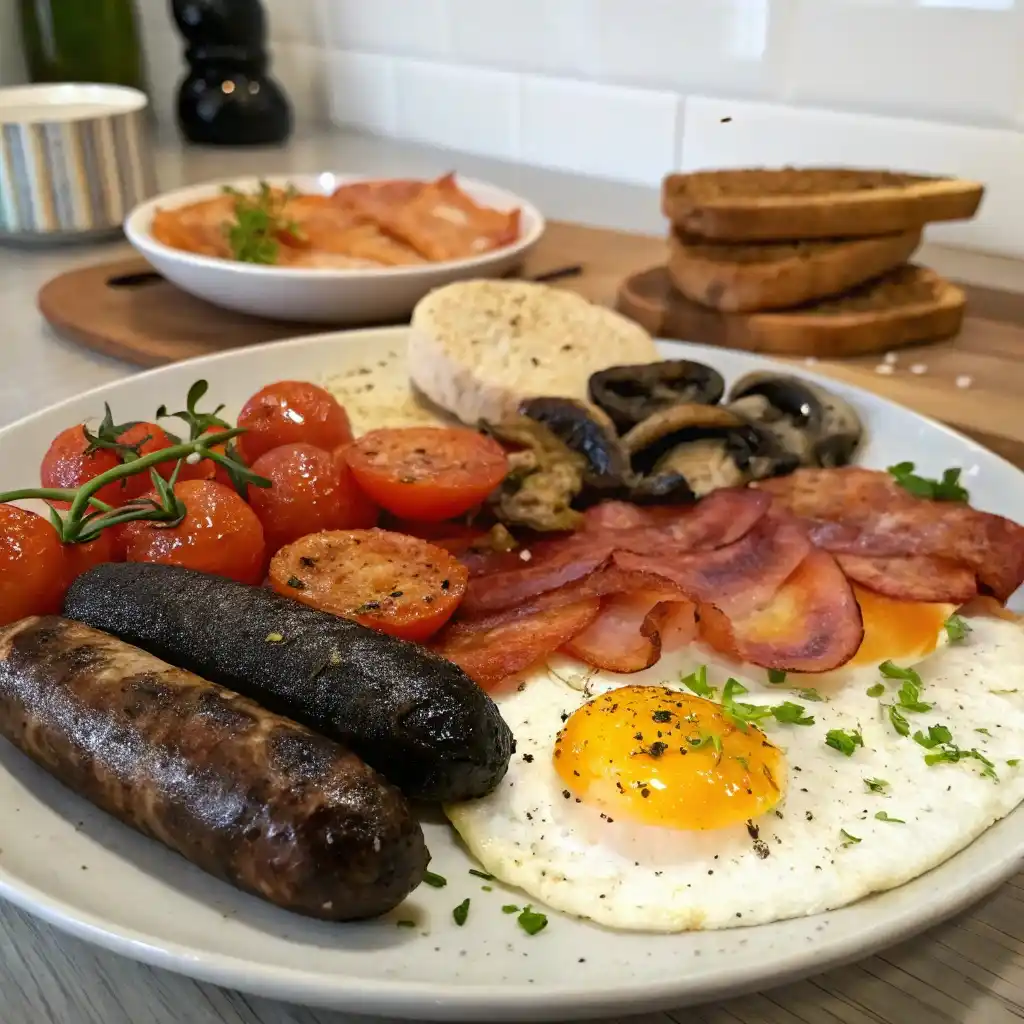
Standard Components of a Full Irish Breakfast
While similar to the Full English, the Full Irish Breakfast includes several unique items:
- Back Bacon: Like the English version, fried or grilled until tender.
- Sausages: Irish pork sausages are often juicier and less herby than British sausages.
- Eggs: Typically fried, but scrambled or poached eggs are also common.
- White Pudding: A lighter version of black pudding, made without blood but with pork, fat, and oats.
- Black Pudding: A traditional blood sausage, similar to the English version.
- Soda Bread: A dense, slightly sweet bread made with baking soda. It is often served toasted.
- Potato Farls: Traditional Irish potato bread, fried or toasted.
- Grilled Tomatoes and Mushrooms: Similar to the English breakfast, these add balance and freshness.
- Boxty (Optional): A traditional Irish potato pancake, occasionally served as a side.
The inclusion of white pudding, soda bread, and potato farls distinguishes the Irish breakfast from its English counterpart, adding regional flair and unique textures.
Both the Full English Breakfast and the Full Irish Breakfast are beloved for their hearty nature and rich history. Yet, their unique components reflect the cultural traditions of their respective regions. Let me know if you’d like further elaboration on additional differences or variations!
Key Differences Between Irish vs English Breakfast
Regional Ingredient Variations
The Full English Breakfast and Full Irish Breakfast share core components such as bacon, sausages, eggs, and grilled tomatoes. However, regional ingredients set them apart:
- Full English Breakfast includes baked beans and fried bread as staples.
- Full Irish Breakfast features distinct items like white pudding, potato farls, and soda bread, adding a unique Irish flair to the plate.
These differences highlight how local traditions and ingredients influence each breakfast.
Cooking Techniques
The cooking methods also vary slightly between the two:
- In the Full English, many items like bacon and sausages are either grilled or fried, often using minimal oil or fat.
- The Full Irish incorporates more frying, especially with potato farls, white pudding, and soda bread, which are often fried in butter or bacon fat for added flavour.
These subtle variations contribute to the rich, hearty nature of both breakfasts.
The Role of Sausages: Irish vs English Breakfast
Key Ingredients in an Irish vs English Breakfast
Types of Sausages Used
Both breakfasts include pork sausages, but the types differ:
- English Sausages: Often seasoned with herbs like sage and thyme, British sausages are known for their savoury, mildly spiced flavour. Popular choices include Cumberland and Lincolnshire sausages.
- Irish Sausages: Irish sausages are juicier and often have a smoother texture due to their higher fat content. They tend to have milder seasoning than their English counterparts.
Flavor Profiles and Preparation Methods
- English Sausages are typically grilled or pan-fried until browned and crispy.
- Irish Sausages are often pan-fried, retaining a slightly softer, juicier texture inside.
While both are hearty and flavorful, the Irish sausage offers a richer, meatier bite, whereas English sausages lean toward a more herby and traditional taste.
White Pudding vs Black Pudding: Irish vs English Breakfast Staples
Understand the role of these traditional puddings and how they differ between the two breakfasts.
What is Black Pudding?
Black pudding is a blood sausage made from pork blood, fat, and oats. It has a rich, earthy flavor and is a traditional component in both the Full English and Full Irish Breakfasts.
Differences in Pudding Recipes Between Regions
- English Black Pudding is typically seasoned with spices like nutmeg, pepper, and cloves, giving it a robust, spicy flavor.
- Irish Black Pudding is slightly milder, often with a smoother texture, and may contain barley or additional oats for richness.
- White Pudding (Irish Only): White pudding is unique to the Irish breakfast and is made without blood. It contains pork fat, oatmeal, and seasonings, resulting in a lighter and creamier texture than black pudding.
The inclusion of white pudding in the Irish breakfast is a key difference. It offers a second type of pudding that complements the meal’s savory components.
Baked Beans or Soda Bread? Irish vs English Breakfast Sides
Discover why baked beans are iconic in the English breakfast and soda bread is essential to the Irish version.
Irish Soda Bread vs. English Toast
Bread plays a significant role in both breakfasts but differs by region:
- Irish Soda Bread: A dense, slightly sweet bread made with baking soda instead of yeast. It is often sliced and toasted, providing a hearty, rustic texture.
- English Toast: Typically made from white or whole-grain bread, English toast is lighter and served buttered. It is a vessel for baked beans, eggs, or sauces.
Unique Bread Accompaniments
- In Full English, toast may be replaced with fried bread, a crispy indulgence cooked in bacon fat.
- The Full Irish often features potato farls, a type of flat potato bread fried for a soft yet crispy bite.
These bread choices add distinct flavours and textures to each breakfast, reflecting the regional food traditions of England and Ireland.
The Full Irish Breakfast and Full English Breakfast share a love for hearty, comforting foods but differ in key elements like sausages, pudding varieties, and bread choices. Each reflects its country’s rich culinary heritage while offering unique flavours that set them apart. Whether you prefer the traditional Full English or the potato-filled richness of the Irish version, both breakfasts deliver a satisfying and cultural dining experience.
Tea vs. Coffee Preferences
Both the Full Irish Breakfast and Full English Breakfast are traditionally served with beverages that complement their hearty flavours:
- Tea: In both regions, tea is the classic choice. Strong, black teas like English Breakfast Tea or Irish Breakfast Tea are typically served with milk and sometimes sugar. Tea is deeply embedded in the cultural identity of both countries, making it the most traditional beverage pairing.
- Coffee: While tea remains popular, coffee has grown in popularity, especially in modern settings. Cafés often serve options like black coffee, lattes, or cappuccinos alongside full breakfasts, catering to changing preferences.
Regional Beverage Choices
- In England, tea continues to dominate, with brands like Yorkshire Tea and Twinings being household favourites.
- In Ireland, strong Irish teas such as Barry’s Tea and Lyons Tea are preferred, reflecting the Irish love for robust and flavorful brews.
Coffee is more prevalent in urban settings, where modern cafés embrace speciality coffee alongside traditional breakfasts.
Vegetarian Alternatives for Full Breakfasts
Meat-Free Options for English and Irish Breakfasts
For those avoiding meat, both the Full English and Irish Breakfasts can be easily adapted to include vegetarian alternatives while retaining their hearty appeal:
- Vegetarian Sausages: Plant-based sausages made with vegetables, soy, or grains replace traditional pork sausages.
- Meat-Free Bacon: Vegetarian bacon substitutes, often made from tempeh or seitan, provide a similar texture and smoky flavour.
- Grilled Vegetables: For a nutritious addition, increase portions of mushrooms, grilled tomatoes, spinach, and bell peppers.
- Eggs: Poached, scrambled, or fried eggs remain a central protein source in vegetarian versions.
- Potato Farls and Hash Browns: Irish and English breakfasts include potato-based components that fit perfectly in vegetarian meals.
- Baked Beans: Naturally vegetarian, baked beans add a hearty, savoury element to the plate.
By replacing meats with plant-based options and increasing vegetable portions, vegetarian Full Breakfasts remain filling and flavorful.
Nutritional Comparison of Both Breakfasts
Caloric Breakdown
Both breakfasts are known for being calorie-dense due to fried components, meats, and bread:
- Full English Breakfast:
- Calories: ~800–1,200 calories (depending on portions and cooking methods).
- High in protein (bacon, sausages, eggs) but also rich in fats.
- Carbohydrates come from baked beans, toast, and hash browns.
- Full Irish Breakfast:
- Calories: ~900–1,300 calories, especially with soda bread, white pudding, and potato farls.
- Contains similar levels of protein but includes more starches (potato farls and soda bread).
- Slightly higher fat content due to the inclusion of white pudding and frying methods.
Health Implications
While both breakfasts are indulgent, they can be enjoyed as part of a balanced diet when eaten occasionally:
- Reduce fat content by grilling items instead of frying.
- Opt for leaner meats or vegetarian alternatives.
- Increase the portion of grilled vegetables for added nutrients.
- Replace white bread with whole-grain toast or soda bread for more fibre.
Making small adjustments can help both breakfasts become healthier without sacrificing flavour.
The Cultural Significance of Irish vs English Breakfast
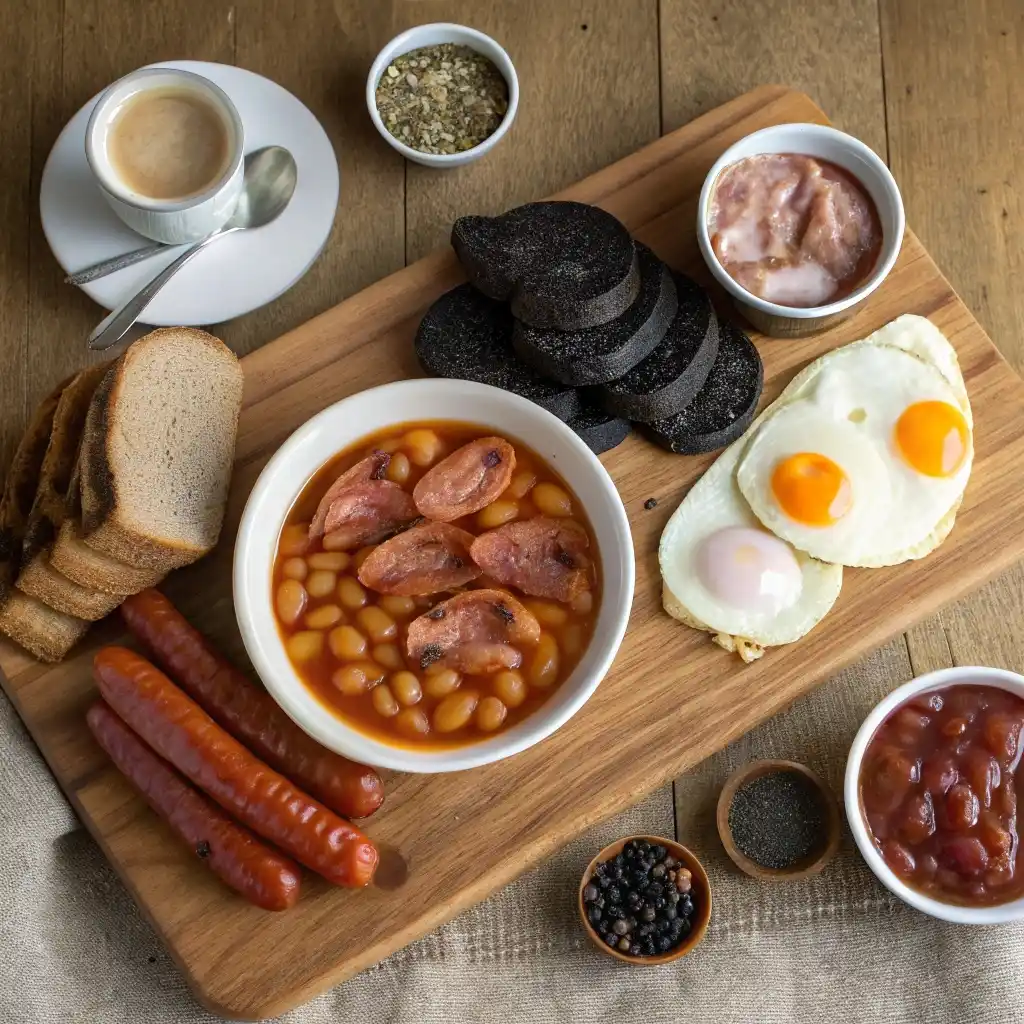
Learn how these traditional breakfasts reflect the culinary heritage of Ireland and England.
Significance in Irish and English Traditions
The Full English Breakfast and Full Irish Breakfast are more than just meals—they are representations of cultural heritage:
- In England, the Full English Breakfast originated as a symbol of hospitality among the gentry and later became a staple for the working class during the Industrial Revolution. It reflects tradition, comfort, and the practicality of hearty, filling meals.
- In Ireland, the Full Irish Breakfast emerged to sustain farmers and labourers through long, hard workdays. Its inclusion of soda bread and potato farls ties it closely to Ireland’s agricultural roots and love for local produce.
Both breakfasts celebrate regional ingredients, history, and the importance of starting the day with a satisfying meal.
Breakfast as a Social Meal
In both Ireland and England, the full breakfast is a social and communal meal, often enjoyed on weekends or special occasions:
- Families and friends gather for leisurely mornings with traditional breakfasts.
- Pubs, cafés, and hotels serve full breakfasts as a symbol of hospitality, drawing in locals and tourists alike.
- The breakfasts offer a sense of nostalgia and cultural pride, evoking memories of home-cooked meals and traditional values.
Ultimately, the Full English and Full Irish Breakfasts are more than food—they are cultural symbols that unite people through shared traditions and hearty flavours.
Why Irish vs English Breakfast Continues to Be Loved
A Hearty Start: Irish vs English Breakfast for Busy Mornings
Both breakfasts are celebrated for fueling long days, thanks to their rich ingredients.
Modern Twists on the Traditional Irish vs English Breakfast
Restaurants and chefs are reinventing these classics with healthier and more creative variations.
While the Full English Breakfast and Full Irish Breakfast maintain their traditional roots, modern restaurants and cafés are giving these classics creative twists to appeal to contemporary tastes:
- Gourmet Ingredients: Restaurants are elevating the quality of meals by using artisanal sausages, organic eggs, and locally sourced bacon.
- Health-Conscious Versions: Healthier options like grilled turkey bacon, plant-based sausages, poached eggs, and whole-grain bread provide a lighter alternative.
- Vegan and Vegetarian Twists: Many establishments offer vegan black pudding, tofu scrambles instead of eggs, and roasted vegetables in place of meat components.
- Fusion Flavors: Some chefs incorporate international flavours, such as serving hash browns with avocado and chilli salsa or adding spices to traditional puddings.
- Deconstructed Breakfasts: Trendy cafés individually present components, offering diners a more artistic and modern breakfast experience.
These innovations maintain the essence of traditional breakfasts while adapting to modern dietary preferences and culinary trends.
Where to Experience Authentic Irish and English Breakfast
Best Places in the UK and Ireland
To enjoy an authentic Full English Breakfast or Full Irish Breakfast, head to these iconic destinations:
In the UK:
- London: Classic pubs like The Wolseley and traditional “greasy spoon” cafés offer authentic English breakfasts.
- The Cotswolds: Charming countryside inns serve hearty, traditional Full English Breakfasts made with local ingredients.
- Yorkshire: Known for its robust portions, Yorkshire cafés add regional specialities like sausage.
In Ireland:
- Dublin: Visit establishments like Queen of Tarts or The Woollen Mills for authentic Full Irish Breakfasts featuring soda bread and black pudding.
- Cork: Known for its high-quality sausages and puddings, Cork cafés offer a true taste of the Irish breakfast tradition.
- Galway: Coastal Irish breakfasts sometimes include fresh seafood alongside traditional components like potato farls.
Tips for Tourists
- Look for Local Cafés: Traditional “greasy spoons” in the UK and family-run pubs in Ireland often serve the most authentic breakfasts.
- Ask for Regional Variations: Request local specialities like white pudding in Ireland or fried bread in England.
- Start Early: Breakfast is best enjoyed fresh in the morning; many cafés stop serving by noon.
- Try Local Beverages: For a true cultural experience, pair your meal with English Breakfast Tea in the UK or Barry’s Tea in Ireland.
FAQs about Full Irish and Full English Breakfasts
1. What are the main differences between a Full English and Full Irish Breakfast?
The Full English includes baked beans and fried bread, while the Full Irish adds white pudding, soda bread, and potato farls.
2. What is black pudding, and is it the same in both breakfasts?
Black pudding is a blood sausage made from pork blood, fat, and oats. The English version is spicier, while the Irish version is milder and sometimes includes barley.
3. Are there vegetarian or vegan alternatives to these breakfasts?
Yes! Modern twists include plant-based sausages, vegan black pudding, scrambled tofu, grilled vegetables, and avocado on toast.
4. How many calories are in a Full English or Full Irish Breakfast?
Both breakfasts range from 800 to 1,200 calories, depending on portion size and cooking methods. Healthier versions use lean meats, grilled items, and whole-grain bread.
5. Can I find Full Irish and Full English Breakfasts outside the UK and Ireland?
Yes! Many international pubs and cafés offer both breakfasts, particularly in areas with strong Irish and British cultural influences.
6. Which drink pairs best with a Full Irish or Full English Breakfast?
Traditional choices include strong black tea (like English Breakfast or Barry’s Tea) or coffee. Fresh orange juice is a lighter option that complements the hearty meal.
Conclusion
Final Thoughts on Their Similarities and Differences
The Full Irish Breakfast and Full English Breakfast are beloved culinary traditions that celebrate the rich flavours of Ireland and England. While both share core components like bacon, sausages, and eggs, the Irish inclusion of white pudding, soda bread, and potato farls sets it apart from the English version, highlighting baked beans and fried bread.
Both breakfasts reflect their respective cultural heritages and continue to bring people together, whether enjoyed at home, in a café, or during travels. Whether you favour the English fry-up or the Irish feast, these iconic meals are a must-try for any breakfast enthusiast.
Want More Cooking Inspiration?
Pancakes with Maple Syrup and Butter: The Ultimate Breakfast Delight
